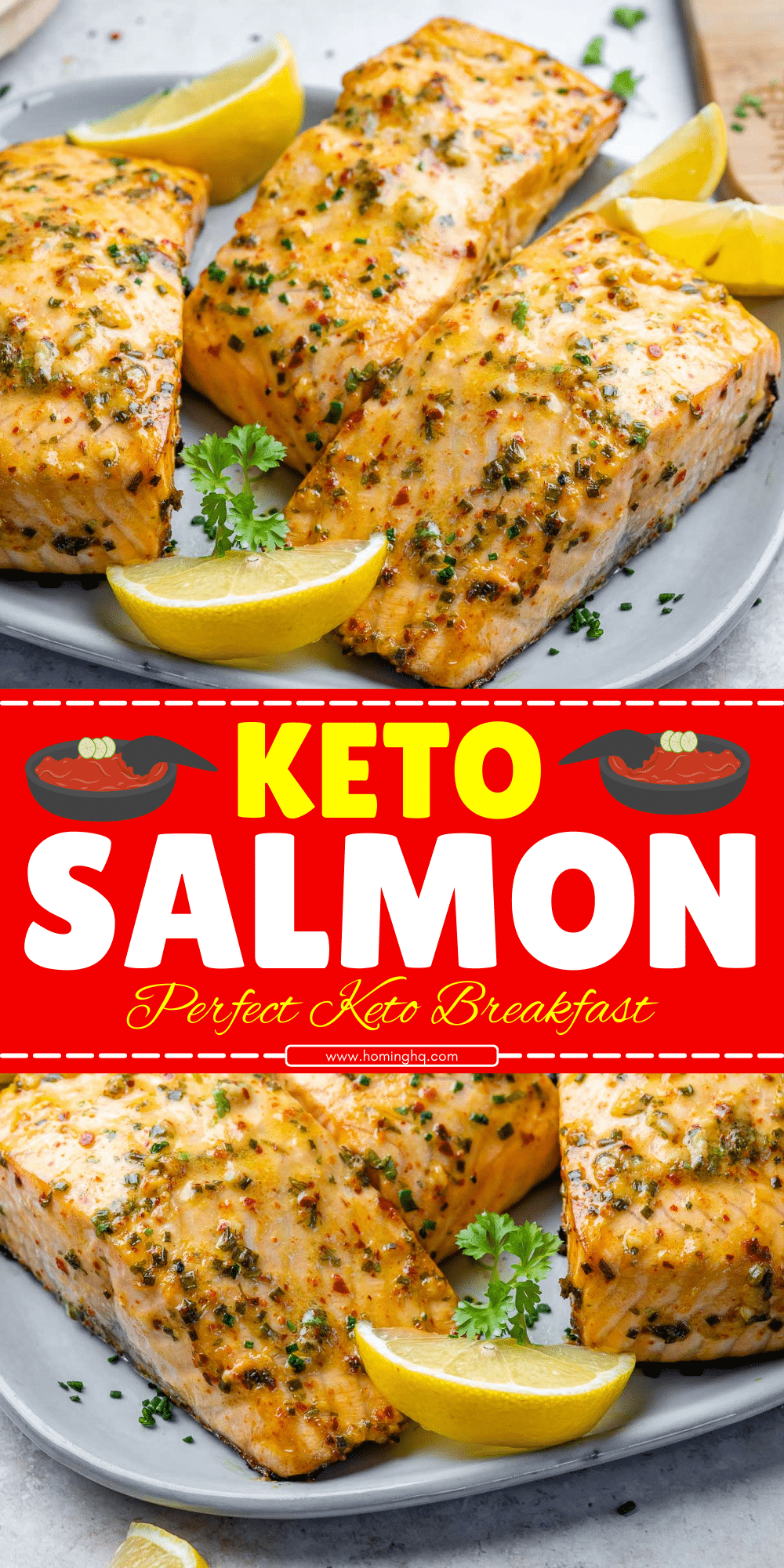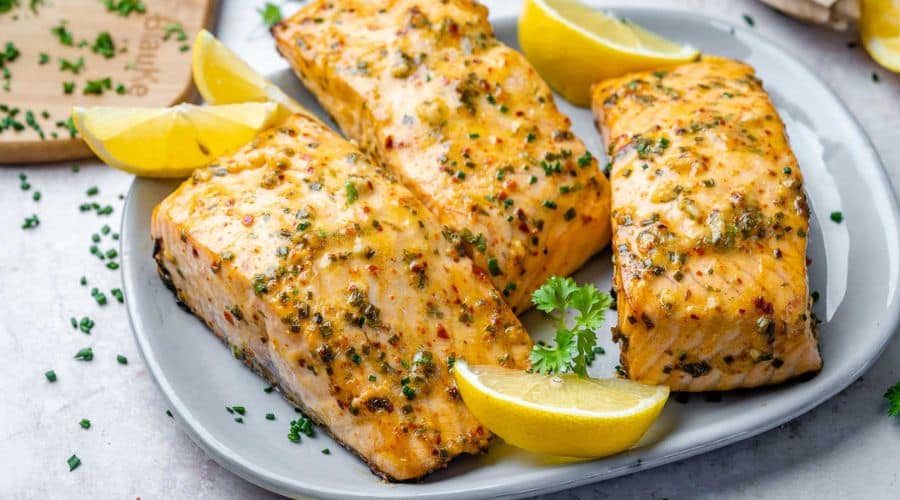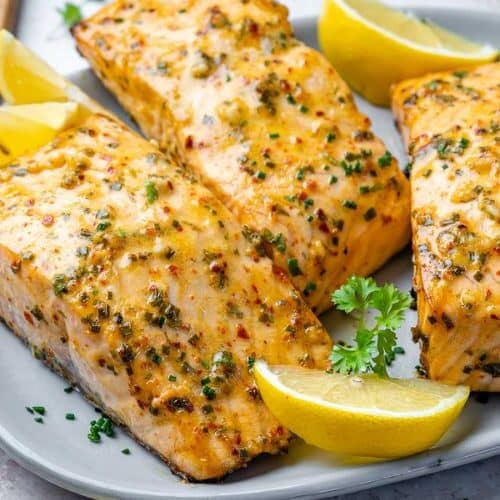All products are selected by our editorial team for quality. If you buy through our links, we may earn a small commission at no extra cost to you.
If you’re following the keto diet, you’re probably looking for delicious ways to incorporate nutrient-dense, low-carb meals into your routine.
Enter Keto Salmon—a perfect fit for anyone looking to enjoy a flavorful and healthy dish that aligns with their keto goals.
Salmon is rich in heart-healthy omega-3 fatty acids and protein, making it an excellent choice for those looking to maintain or reach ketosis.
Whether you’re a keto beginner or a seasoned expert, this recipe promises to satisfy your taste buds while helping you stay on track with your dietary goals.
In this blog, we’ll walk you through how to prepare and cook Keto Salmon in a variety of ways, providing you with a versatile dish that’s not only low in carbs but also packed with nutrients.

Ingredients Needed for Keto Salmon
To create this simple and delicious Keto Salmon recipe, you’ll need a few key ingredients.
These items come together to deliver a flavorful, satisfying meal that fits perfectly within your low-carb lifestyle.
Salmon Fillets
The star of the dish—wild-caught salmon fillets are ideal for their fresh flavor and high omega-3 content.
If wild-caught isn’t available, farmed salmon will also work, but make sure to choose high-quality cuts.
Olive Oil or Avocado Oil
These healthy fats are perfect for grilling, baking, or pan-searing your salmon.
Both oils are rich in monounsaturated fats, which are great for your heart and overall health.
Garlic
Fresh minced garlic will infuse the salmon with aromatic flavor, enhancing the natural richness of the fish without adding any carbs.
Lemon
A squeeze of fresh lemon juice brightens the flavor and adds a refreshing tang to the rich salmon.
Fresh Herbs
A mix of fresh herbs like parsley, dill, or thyme complements the salmon’s flavor.
You can use dried herbs if fresh ones aren’t available, but fresh adds a special touch.
Salt and Pepper
Simple seasonings that bring out the best in the fish. Be sure to season generously to elevate the overall flavor.
Optional: Dijon Mustard or Coconut Aminos
For a bit of extra zing, you can add a small amount of Dijon mustard or coconut aminos (a low-carb alternative to soy sauce).
These are optional but can add a unique depth to the marinade.
With these ingredients, you’ll be able to craft a meal that’s full of flavor while keeping it perfectly in line with your keto diet.
Let’s dive into how to bring all these components together!
Step-by-Step Guide to Making Keto Salmon

Creating the perfect Keto Salmon is simple and straightforward, and it all starts with the right preparation. Here’s how to make it:
Preparing the Salmon
Start by selecting fresh, high-quality salmon fillets.
Whether you’re using wild-caught or farmed, make sure they are fresh and free from any excess moisture.
Pat the fillets dry with a paper towel to ensure they cook evenly.
Next, season your salmon with salt and pepper.
Feel free to get creative with additional seasoning, like garlic powder, onion powder, or even a bit of paprika for added color and flavor.
A drizzle of olive oil or avocado oil will also help the seasoning adhere and provide the perfect cooking base.
Cooking Methods: Baked, Grilled, or Pan-Seared
Baked Keto Salmon
Preheat your oven to 400°F (200°C). Place your seasoned salmon fillets on a baking sheet lined with parchment paper or aluminum foil.
Bake for about 12-15 minutes, depending on the thickness of the fillet. The salmon should flake easily with a fork when done.
If you prefer crispy edges, broil for an additional 2-3 minutes.
Grilled Keto Salmon
Preheat your grill to medium-high heat. Lightly oil the grill grates and place the salmon skin-side down.
Grill for about 4-5 minutes per side, or until the internal temperature reaches 145°F (63°C). Be careful when flipping the fillets to avoid breaking them.
Pan-Seared Keto Salmon
Heat a tablespoon of olive oil in a non-stick skillet over medium-high heat.
Add the salmon fillets skin-side down and cook for 4-5 minutes.
Flip the fillets carefully and cook for another 3-4 minutes, or until the salmon is fully cooked through.
Keto-Friendly Seasoning for Salmon
The beauty of Keto Salmon lies in its simplicity, but that doesn’t mean you can’t enhance the flavor.
A squeeze of fresh lemon juice after cooking will add brightness, while a sprinkle of fresh herbs like parsley or dill can add an aromatic touch.
For an extra boost of flavor, consider using a Dijon mustard glaze or a splash of coconut aminos before cooking.
Tips for Perfect Keto Salmon Every Time
To ensure your Keto Salmon turns out perfectly every time, here are a few expert tips:
1. Monitor the Cooking Time Carefully
Salmon can dry out quickly if overcooked. For perfectly cooked salmon, aim for an internal temperature of 145°F (63°C).
The fillets should be opaque and flake easily when tested with a fork.
If you don’t have a meat thermometer, check the salmon by gently pressing on the top with a fork—if it flakes easily, it’s ready.
2. Don’t Overcrowd the Pan or Grill
When cooking multiple fillets, make sure there’s enough space between them.
Crowding the cooking surface can cause uneven cooking and prevent the salmon from getting that perfect sear or crispy skin.
3. Let the Salmon Rest Before Serving
Allow the salmon to rest for a few minutes after cooking.
This helps retain the moisture inside, resulting in a juicier fillet. Resting also allows the flavors to settle and intensify.
4. Experiment with Flavor Variations
While lemon and garlic are classic choices, feel free to experiment with different herbs and spices.
A little smoked paprika or a pinch of red pepper flakes can elevate the flavor.
If you like a bit of sweetness, a small drizzle of sugar-free maple syrup or a touch of stevia can add a unique twist without kicking you out of ketosis.
5. Use Fresh Salmon When Possible
Fresh salmon tends to have a better texture and flavor than frozen, but if frozen is your only option, make sure to thaw it properly in the fridge to avoid sogginess.
Always check for any unwanted ice crystals before cooking.
By following these tips and the step-by-step guide, you’ll create perfectly cooked Keto Salmon every time—tender, flaky, and full of flavor!
Storing and Reheating Leftover Keto Salmon
Leftover Keto Salmon can be just as delicious the next day if stored and reheated properly.
Here’s how to keep your salmon fresh and tasty for future meals:
Storing Leftover Keto Salmon
Once your salmon has cooled to room temperature, place the leftover fillets in an airtight container.
You can store it in the refrigerator for up to 2-3 days.
For longer storage, wrap the salmon tightly in plastic wrap or aluminum foil and place it in a freezer-safe container or bag.
Frozen salmon can be kept for up to 2-3 months, though it’s best to consume it within a month for optimal flavor.
Reheating Leftover Keto Salmon
When it’s time to enjoy your leftover salmon, it’s important to reheat it gently to preserve the texture and moisture.
Here are a few methods for reheating:
- Oven Method: Preheat your oven to 300°F (150°C). Place the salmon on a baking sheet and cover it with foil to prevent it from drying out. Heat for about 10-12 minutes, or until warmed through.
- Pan-Seared Method: Reheat the salmon in a non-stick skillet over low to medium heat for 2-3 minutes per side. You can add a little oil or butter to help retain moisture and add flavor.
- Microwave Method: If you’re in a rush, the microwave can work, but be careful not to overdo it. Place the salmon on a microwave-safe plate and cover it with a damp paper towel. Heat for 30-45 seconds in intervals until the salmon is warm.
While reheating, avoid overcooking the salmon to prevent it from becoming dry and tough. Reheating in smaller portions rather than all at once will also help maintain better texture.
Conclusion
Keto Salmon is an easy, flavorful, and nutritious dish that fits perfectly into your low-carb lifestyle.
Whether you prefer it baked, grilled, or pan-seared, this simple recipe offers versatility while ensuring you stay on track with your keto diet.
Packed with healthy fats and protein, salmon is an ideal choice for anyone looking to maintain a balanced diet and achieve ketosis.
The best part? It’s just as delicious the next day!
By following the tips for storing and reheating, you can enjoy leftover Keto Salmon without sacrificing taste or texture.
Whether it’s part of your weekly meal prep or a quick dinner solution, this recipe is sure to become a staple in your keto menu rotation.
Frequently Asked Questions
1. Can I use frozen salmon for this recipe?
Yes, you can!
While fresh salmon is ideal, frozen salmon can be used as well.
Just make sure to thaw it properly in the fridge before cooking for the best results.
If using frozen salmon, make sure it is fully defrosted before seasoning and cooking.
2. What’s the best type of salmon for keto?
Wild-caught salmon is generally considered the best option due to its higher omega-3 fatty acid content.
However, farmed salmon can also be used, especially if wild-caught is unavailable or more expensive.
Both options are keto-friendly!
3. How do I know if my salmon is cooked properly?
Salmon is done when it reaches an internal temperature of 145°F (63°C) or when it flakes easily with a fork.
If you’re unsure, using a meat thermometer will help you achieve the perfect doneness every time.
4. Can I add a marinade to my keto salmon?
Yes! You can marinate your salmon in a keto-friendly marinade. Just avoid sugars or high-carb ingredients.
A mixture of olive oil, lemon juice, garlic, and fresh herbs makes for a simple and delicious marinade.
5. Can I make keto salmon in advance?
Absolutely! You can prepare and cook your salmon in advance for meal prep or convenience.
Store the cooked salmon in an airtight container in the fridge for up to 3 days, or freeze it for longer storage.

Keto Salmon
Equipment
- 1 Baking Sheet (for baking salmon)
- 1 Non-Stick Skillet (for pan-searing)
- 1 Grill (for grilling salmon)
- 1 Oven (for baking)
- 1 Meat Thermometer (optional but recommended for perfect doneness)
Ingredients
- 4 salmon fillets about 6 oz each
- 1 tbsp olive oil or avocado oil
- 2 cloves garlic minced
- 1 lemon sliced or juiced
- 1 tbsp fresh herbs parsley, dill, or thyme, chopped
- Salt to taste
- Pepper to taste
- Optional: 1 tbsp Dijon mustard or 1 tbsp coconut aminos for added flavor
Instructions
Preheat your oven or grill:
- If you’re baking the salmon, preheat your oven to 400°F (200°C). For grilling, heat the grill to medium-high heat.
Prepare the salmon:
- Pat the salmon fillets dry with paper towels. Drizzle with olive oil or avocado oil, then rub the minced garlic evenly over each fillet. Season generously with salt and pepper. If you like, you can also add Dijon mustard or coconut aminos for extra flavor.
Bake the salmon (if using oven):
- Place the salmon fillets on a baking sheet lined with parchment paper or aluminum foil. Bake for 12-15 minutes, depending on the thickness of the fillet. The salmon should be opaque and flake easily with a fork when done.
Grill the salmon (if using grill):
- Place the salmon fillets on the preheated grill, skin-side down. Grill for 4-5 minutes on each side, or until the internal temperature reaches 145°F (63°C). Use a spatula to flip the salmon carefully to prevent it from breaking.
Pan-sear the salmon (if using skillet):
- Heat a non-stick skillet over medium-high heat and add olive oil. Once hot, place the salmon fillets skin-side down. Cook for 4-5 minutes, then flip and cook for another 3-4 minutes, until cooked through and flakes easily.
Finish with lemon and herbs:
- After cooking, squeeze fresh lemon juice over the salmon fillets and sprinkle with fresh chopped herbs for added flavor.
Serve:
- Serve immediately with keto-friendly sides such as zucchini noodles, cauliflower rice, or roasted vegetables.
Notes
- Frozen Salmon: If you’re using frozen salmon, make sure to thaw it properly in the refrigerator before cooking for the best texture and flavor.
- Skin-on vs. Skinless: You can use skin-on or skinless salmon fillets. Skin-on fillets tend to hold together better and offer extra flavor.
- Cooking Time: The cooking time may vary depending on the thickness of your salmon fillets. Always check for an internal temperature of 145°F (63°C) for perfect doneness.
- Make Ahead: This recipe can be prepared ahead of time and stored in the fridge for up to 2-3 days. It also freezes well if you have leftovers.

